
Taxodium: Planting, Cultivation, and Care
Contents
The Taxodium in a few words
- This is a large deciduous conifer with the unique characteristic of shedding its leaves in autumn.
- Its bright green foliage in spring adorns itself with splendid autumnal hues before falling.
- It is one of the few conifers that thrive in waterlogged to moist soils.
- Very hardy, it also does well in ordinary, deep soil that remains cool.
- It is ideal for waterside or marshland scenes.
the word from our expert
The Taxodium, particularly the Taxodium distichum, nicknamed the Bald Cypress or Louisiana Cypress, is a remarkable conifer in more ways than one! Among the vast family of conifers, it is one of the few members to shed its foliage in autumn, hence its vernacular name “Bald Cypress.” But before shedding its splendid attire, this deciduous conifer enhances the garden with its feathery, soft-to-the-touch foliage, a vibrant green in spring that turns into stunning autumnal hues of rust and golden-brown before falling. Though it becomes bare in the dull season, it loses none of its majesty in winter!
The Taxodium will grow into an exceptional tree, enduring through the centuries and becoming the pride of the gardener who planted it. It is one of those trees that never truly die, boasting a lifespan of over 1,000 years! With its pyramidal habit and a mature height of 20 to 25 metres, it is best suited for spacious gardens. This light-loving and moisture-tolerant essential oil deserves a prime location! Fortunately, certain varieties like ‘Pevé Minaret’, which does not exceed 3 metres in height and 1 metre in spread, are well-suited for medium-sized gardens or containers on the terrace.
Highly hardy and disease-resistant, it is also one of the few conifers that thrive in waterlogged and marshy soils, though it adapts well to ordinary, deep, and consistently moist soils. It requires little to no maintenance after the first few years, needing only soil that never dries out.
If you have a large garden with moist soil or a water feature, let this Louisiana giant tempt you!

Taxodium distichum
Description and Botany
Botanical data
- Latin name Taxodium
- Family Taxodiaceae
- Common name Bald cypress, Louisiana cypress
- Flowering April
- Height 3 to 25 m
- Exposure Sun, partial shade
- Soil type Clay (heavy), loamy (rich and light), moist
- Hardiness -20°C and beyond
The Taxodium is a conifer from the Taxodiaceae family, much like the sequoias and the metasequoias. It grows naturally in waterlogged to moist soils. It is emblematic of the marshlands and riverbanks of the southeastern United States, from Mississippi to the Florida Everglades, as well as Mexico. It is particularly common in the bayous of Louisiana. The bald cypress was introduced to France in the mid-18th century. The genus Taxodium includes only two species: Taxodium distichum, also known as the Bald Cypress or Louisiana Cypress due to its deciduous foliage, which has given rise to several varieties, such as the dwarf cultivar ‘Pevé Minaret’, and Taxodium ascendens, or the pond cypress, which has a trailing habit. Their unique feature is their deciduous foliage, unlike most conifers, which are evergreen.
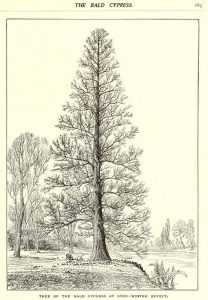
Bald cypress illustration (circa 1903)
When growing in flooded areas, this type of conifer rises on pneumatophores, characteristic roots—lignified outgrowths (absent in well-drained soils)—that emerge up to 1.5 m high above the ground or water around the trunk. These appear on mature specimens (25-30 years old) and allow the root system to capture atmospheric oxygen while anchoring the tree in shifting, regularly submerged soils.
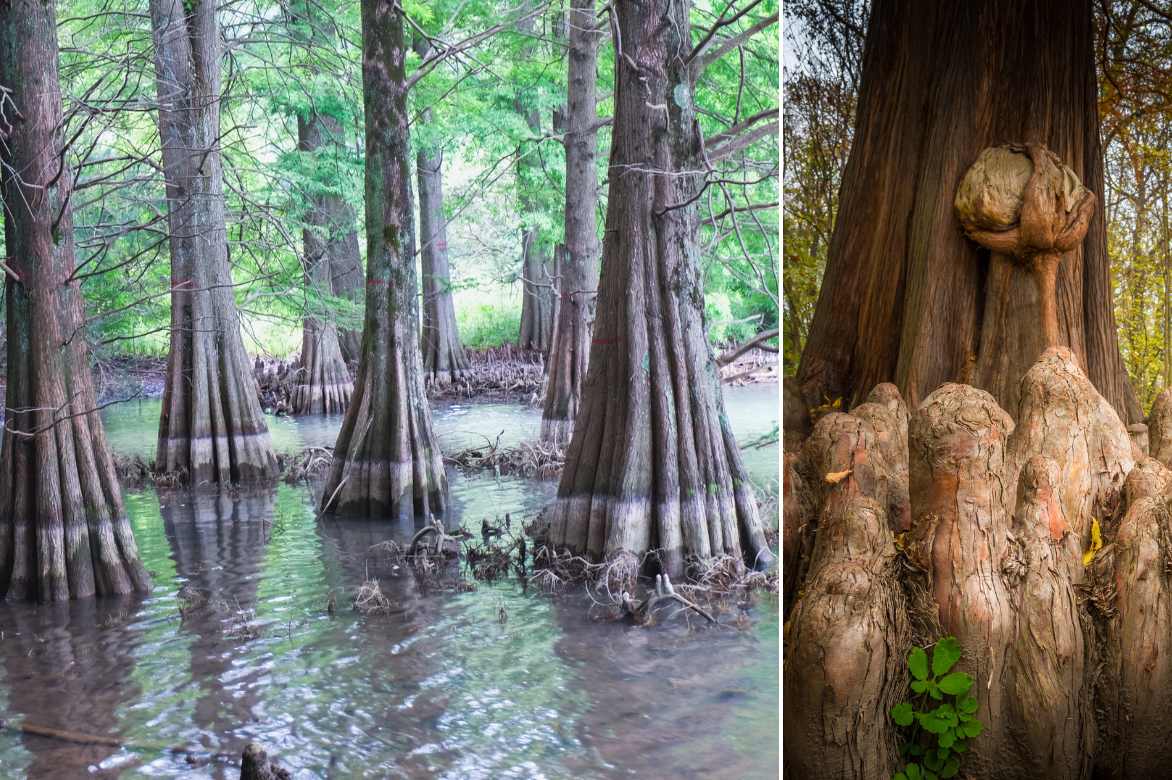
The characteristic roots of the Taxodium planted in moist environments
This cypress has an airy conical silhouette that becomes more rounded over time. In its natural habitat, the Bald Cypress forms a large conifer with a pyramidal habit, becoming more columnar with age, reaching nearly 40 m in height with a trunk diameter of 2 m. In our gardens, its mature size will be limited to 20-25 m in height and 7-8 m in spread. Its growth is rapid, and its longevity is exceptional; it can live for nearly 500 years. Some cypresses have been standing for centuries, often outliving several generations. The Taxodium ascendens ‘Nutans’ has more modest dimensions, growing 8 to 15 m tall in cultivation with a spread of 2-3 m. It is better suited to medium-sized gardens and boasts a lifespan of 1,000 years! The cultivar ‘Pevé Minaret’ is the dwarf version of the Bald Cypress, not exceeding 3 m in height and 1 m in spread, making it ideal for smaller spaces.
The fibrous, very knotty trunk is covered with thick reddish-brown bark, deeply furrowed, channelled, and cracked with age. Over time, it widens at the base and twists into a spiral.
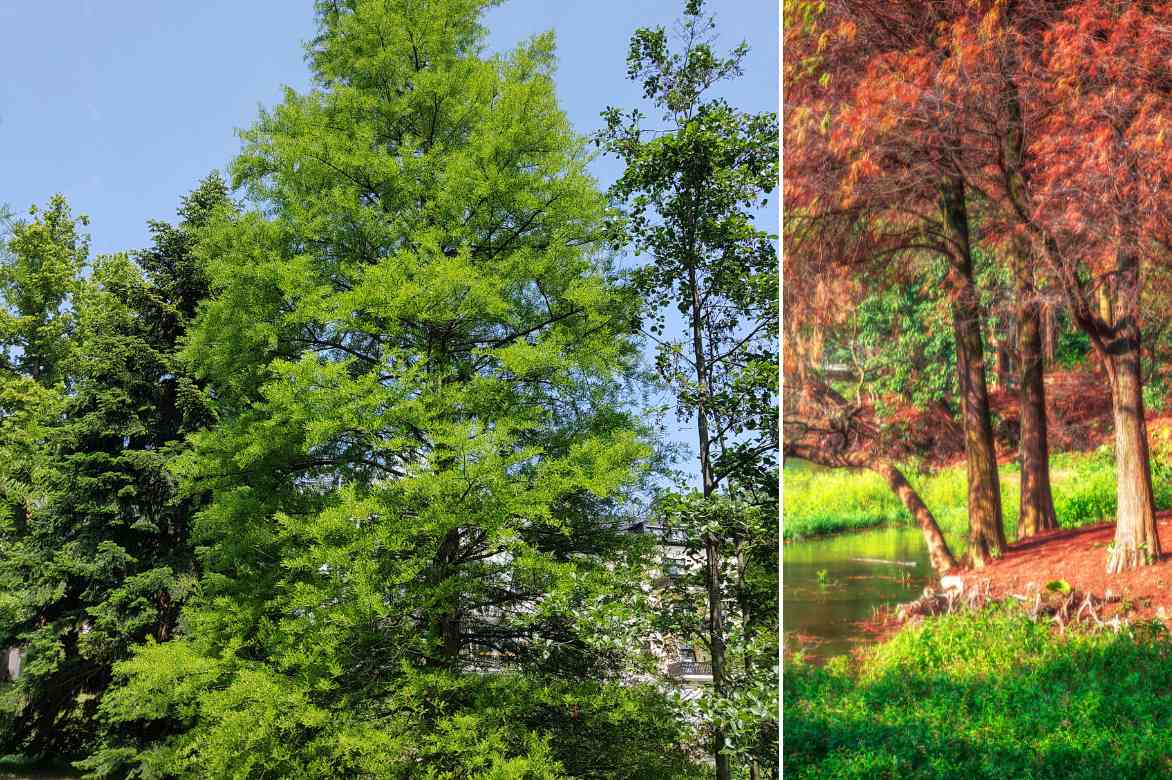
Silhouette of Taxodium distichum
The Taxodium is remarkable for its fine, light, and changing foliage, which adorns itself with splendid hues in autumn, filling the garden with warm, spicy colours. Its long branches divide into persistent shoots bearing deciduous branchlets. It is one of the few conifers to shed its branchlets and spurs in autumn. Its branchlets are adorned with non-prickly, flattened needle-like leaves, a fresh green at bud burst. They turn golden shades in autumn before falling. These soft, upright needles, measuring 1 to 2 cm in length, are arranged spirally in a single row, unlike the Metasequoia, whose needles are placed opposite each other. They resemble those of the yew (Taxus baccata) and give the illusion of being arranged in two opposite rows along a common shoot, hence the plant’s name: taxus meaning yew, dis and stikhos, two rows.
As with monoecious species, male and female cones coexist on the same plant. In spring, male inflorescences in the form of small catkins on short shoots release their pollen. The very discreet female flowers, nestled at the base of the male catkins, transform after fertilisation into globular, scaly, and pedunculate cones, 2 to 3 cm in diameter, initially green, then brown, arranged directly on the shoots in terminal clusters 10 to 30 cm long. They feature imbricate scales that retract at maturity, releasing seeds.
Its soft, rot-resistant wood, lightweight, easy to work with, and resistant to wood-boring insects like termites, is prized for furniture, cabinetry, and construction. Its crushed bark makes excellent mulch, similar to pine.
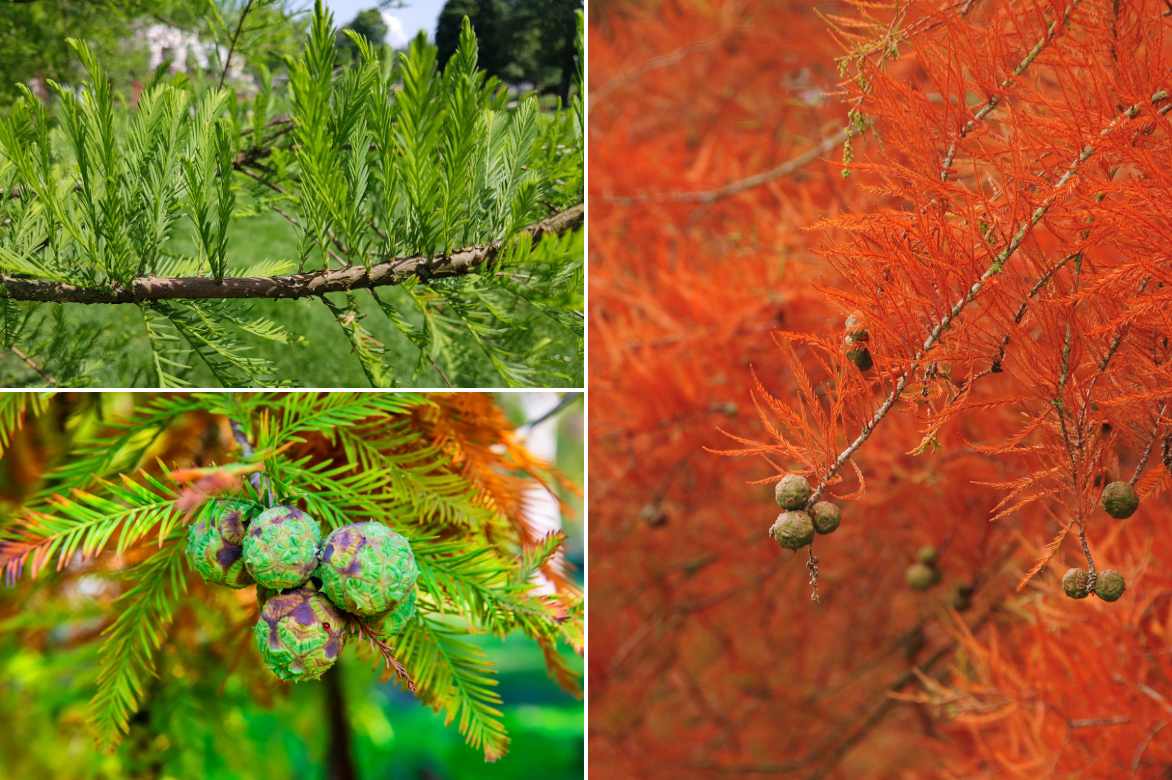
Summer and autumn foliage of the Taxodium. Bottom left, the fruiting
Main species and varieties
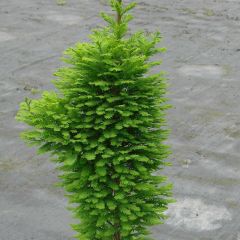
Taxodium distichum Pevé Minaret - Swamp cypress
- Height at maturity 3 m
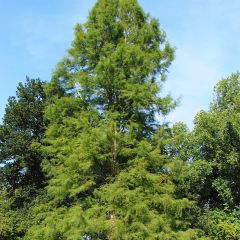
Taxodium distichum - Swamp cypress
- Height at maturity 20 m
Discover other Conifers A to Z
View all →Available in 1 sizes
Available in 2 sizes
Available in 1 sizes
Available in 3 sizes
Available in 1 sizes
Available in 1 sizes
Available in 1 sizes
Available in 1 sizes
Available in 1 sizes
Planting the Taxodium
Where to Plant a Bald Cypress?
Hardy to at least -15°C, the Taxodium can withstand harsh winters, making it suitable for planting in the coldest regions of our country. This native of wetlands and marshes will likely be less comfortable in Mediterranean regions, as it cannot tolerate dry soils or drought. While it thrives in constantly moist, even flooded, soils and grows in shallow water, it can adapt to any ordinary, deep, and cool soil. In such cases, its growth will be slower. It requires a certain level of soil moisture to develop rapidly. However, it prefers a slightly acidophilous soil with low limestone content. Choose a very sunny location, although it can tolerate partial shade.
This tree does not transplant well: so carefully consider the planting location beforehand and allocate it ample space, as the typical species can easily exceed 20m in height and 10-12m in width at maturity. To best showcase its ornamental qualities, reserve it a relatively open spot in the garden, free from excessive competition. In a medium-sized garden or a city garden, opt for a less bulky and slower-growing variety than the standard type, such as ‘Pevé Minaret’.
It can be cultivated as an ornamental tree in parks and large gardens, or as a standalone feature in the centre of a flowerbed or near a pond. Smaller varieties will thrive in a large container on a terrace or balcony.
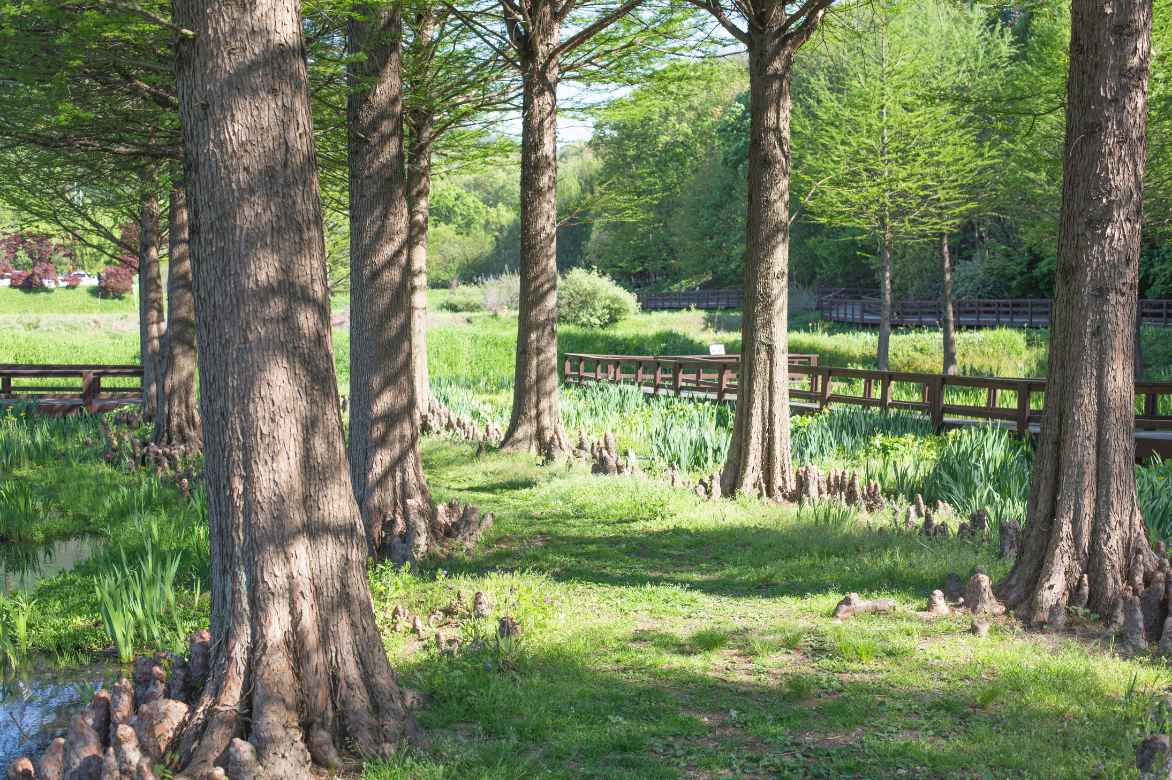
Bald cypresses need ample space to fully express themselves
When to Plant a Bald Cypress?
Planting a Bald Cypress is best done in autumn, from September to November, to allow it to establish roots before winter, always avoiding frost periods.
How to Plant It?
In highly limestone soil, we recommend adding heather soil during planting. Allow at least 8 to 10m between its base and another tree, wall, or fence.
- Dig a planting hole 3 times wider than the root ball
- Use a digging fork to loosen the soil thoroughly to a depth of 80cm
- Spread gravel to ensure good drainage around the roots
- Add manure or compost if the soil is too sandy
- Plant the tree without burying the base of the trunk
- Place 1 to 3 stakes outside the root ball if needed
- Firm the soil and water generously until established
- Mulch around the base to keep the soil cool in summer
Cultivation, care, pruning
This is an easy-to-grow conifer as long as the soil remains consistently moist. Water deeply and generously during the first two summers and be vigilant during hot, dry weather. The soil should never dry out completely. A good mulch is recommended. Spread a thick layer of organic mulch (such as pine bark, which will slightly acidify the soil) to retain moisture around the roots and reduce the need for watering.
Pruning is not necessary, and it’s even preferable not to prune the bald cypress. If absolutely necessary, limit yourself to an annual maintenance trim before the growing season to remove dead, obstructive, or superfluous branches. The bald cypress is resistant to diseases and parasites.
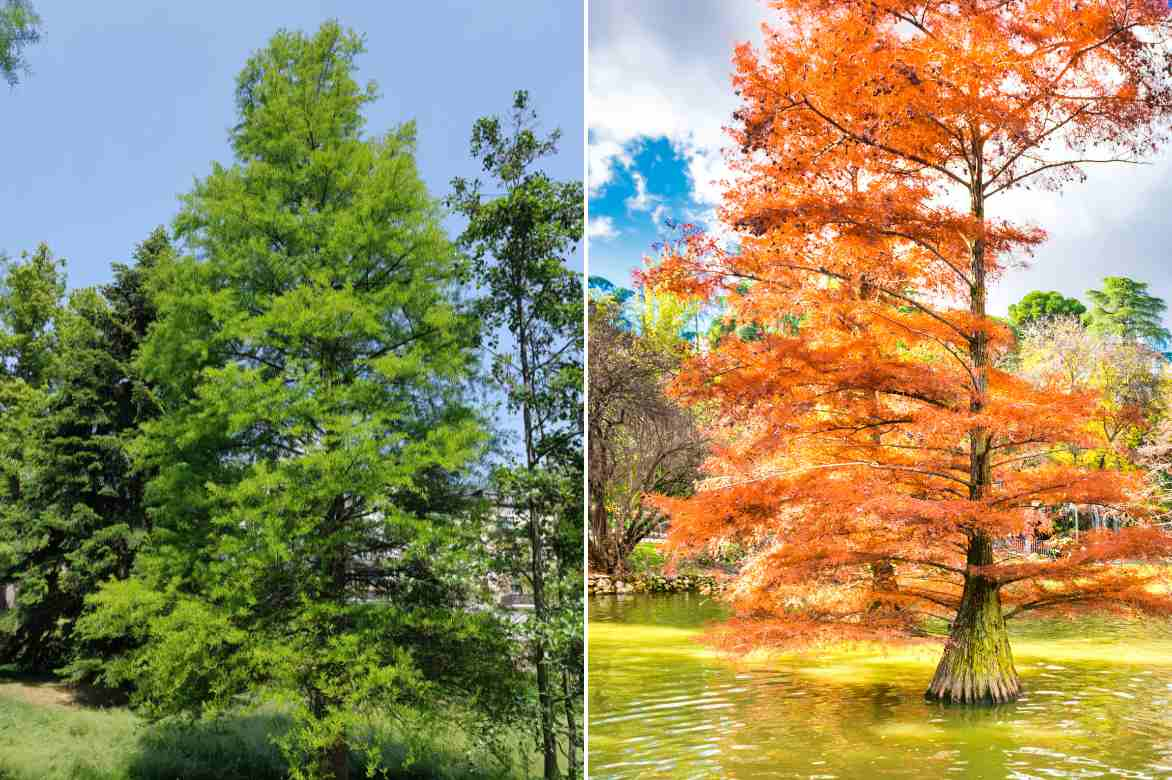
Bald cypress in summer and autumn
Multiplication
Although sowing is possible, the propagation of Taxodium is most commonly done by propagation by cuttings in late summer on hardwood.
By cuttings
- Take dry shoot tips about 15 cm long
- Remove the leaves near the base of the cutting and scrape the bark just below a node for about 1 cm in length
- Insert these into moist sand
- Place in a humid environment in partial shade, and bring indoors to protect from frost during winter
- Open regularly to prevent rotting
- In spring, transplant the rooted cuttings into pots containing a mixture of compost and heather soil, and keep them until planting in the ground in autumn
→ Discover our tutorial: How to take cuttings from conifers?
Associations
The Taxodium distichum thrives ideally near a pond, on the banks of a lake, or along a watercourse, where it will fully express its potential as a specimen tree. Although it generally stands out on its own as a focal point, it pairs easily with bushes or perennials that appreciate the same growing conditions: neutral to acidic and moist soil, light shade, or sun. With its golden autumn foliage, it makes a striking addition to beautiful autumnal settings.
Around a water feature, it will flourish alongside remarkable trees like the Nyssa or black tupelo, which also requires slightly acidic, moist to very wet soil and bursts into fiery hues in autumn, as well as bank perennials such as Acorus gramineus, the highly graphic Equisetum hyemale (japonicum), and Astilbes. Also consider submerged plants like the Iris pseudacorus.
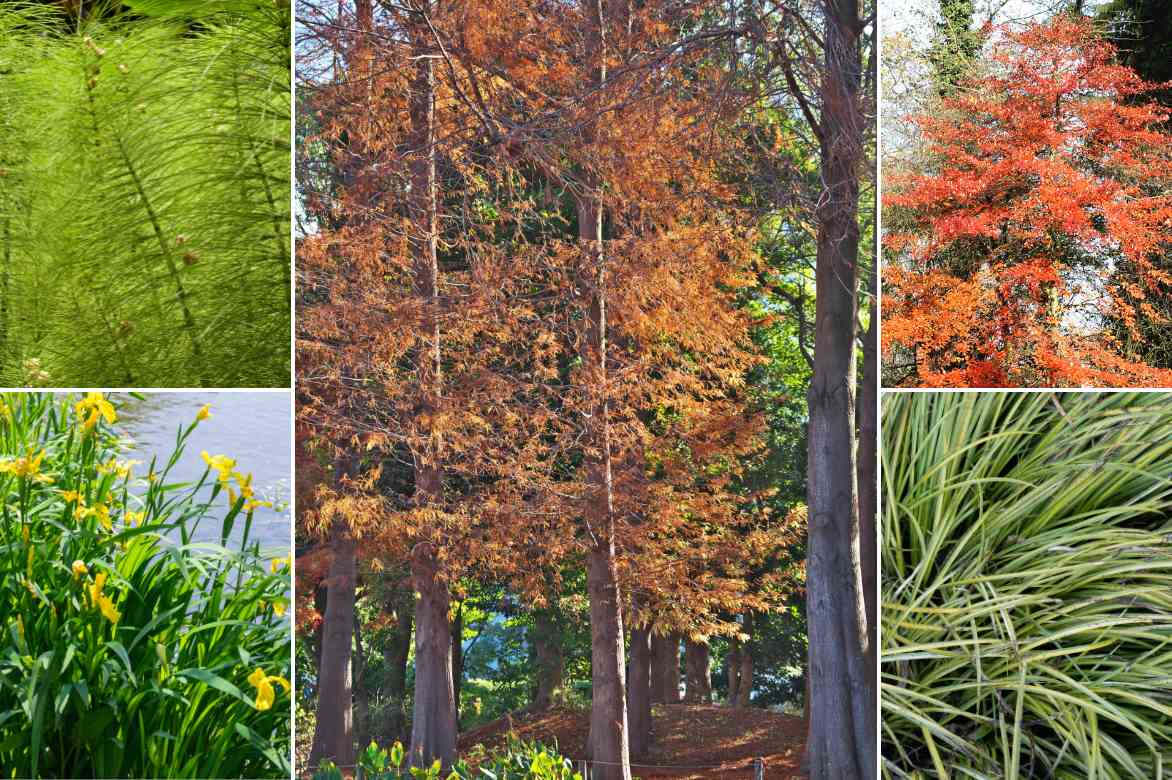
Bald cypress, surrounded by Equisetum hyemale, Iris pseudacorus, Nyssa sylvatica, and Acorus gramineus
In a garden spacious enough to accommodate it, you can plant it alongside its cousin, the Metasequoia glyptostroboides ‘Gold Rush’, another large deciduous conifer with magnificent foliage that thrives in waterlogged soils. The bald cypress pairs well with this type of large conifer featuring autumn foliage, such as the Larch.
In a cool to moist bed, you can also plant at its base beautiful ferns like Onoclea sensibilis, Matteuccia orientalis, and Thelypteris palustris, along with some hostas that tolerate sun. For bushes, consider the foliage of Aucubas, and that of Cornus alba, stolonifera, or sanguinea, bushes with remarkable foliage and wood.
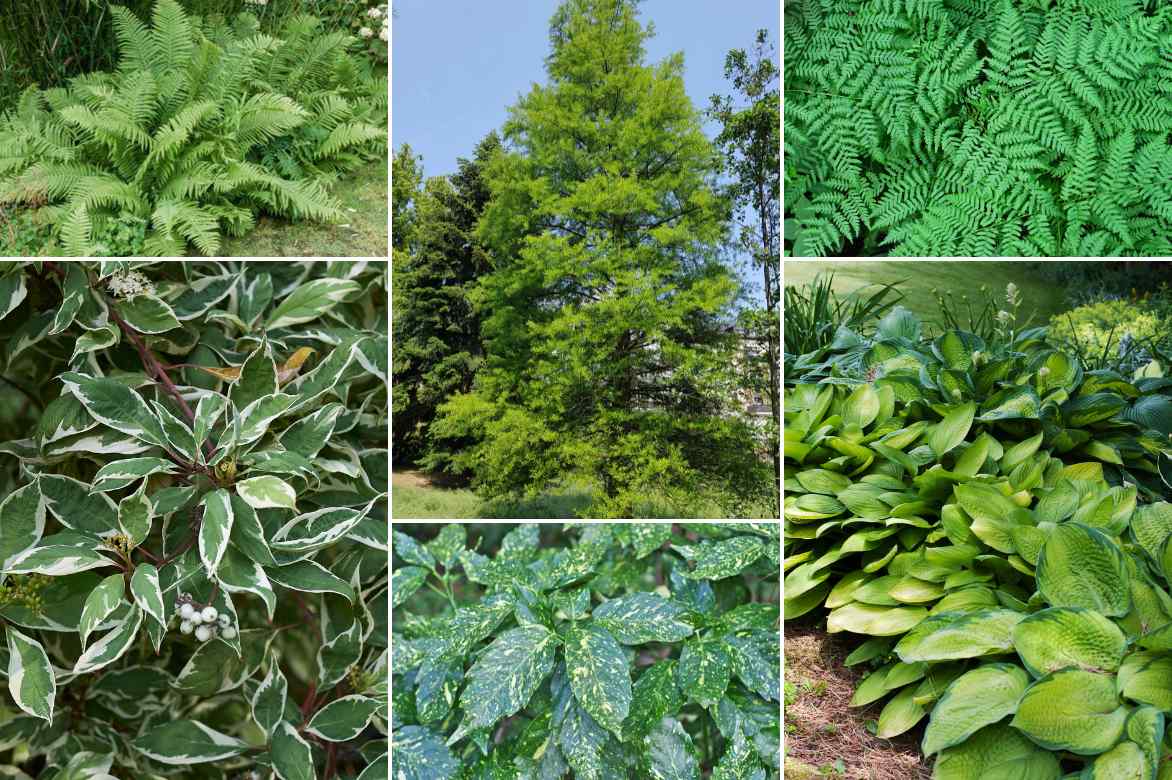
Bald cypress at the top centre, in a mix featuring Matteuccia orientalis, Cornus alba, Aucuba japonica, the beautiful marsh fern (Thelypteris palustris), and Hostas
Since the Taxodium distichum (Bald cypress) thrives in slightly acidic soils, it can serve as a backdrop for a mix of heather soil bushes.
You can set the garden ablaze at the end of the season by pairing it with trees and bushes with colourful foliage such as the Liquidambar and the Caramel Tree.
Useful resources
- Discover our range of Cupressus
- Also explore our selection of aquatic perennials
- Subscribe!
- Contents































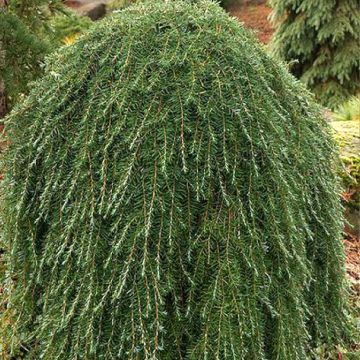
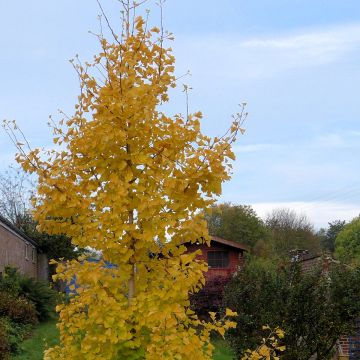

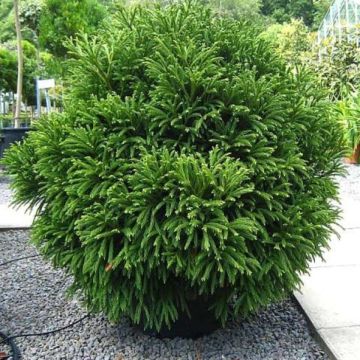
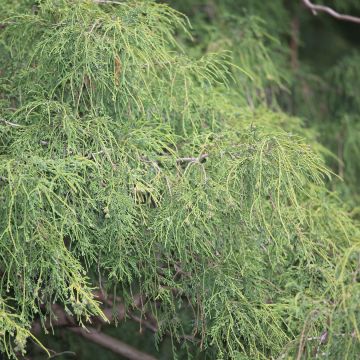




Comments